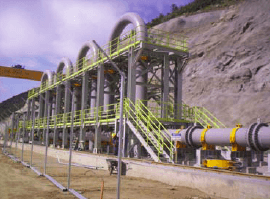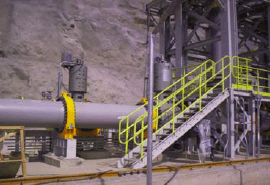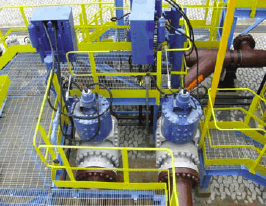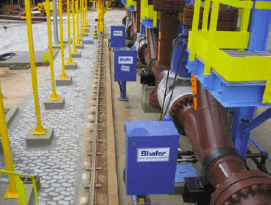In today’s guest post, Emerson’s Mike McQuade describes slurry-mining applications where rotary vane actuators are well suited.
In a slurry-type mining application, the ore is ground up into fine particles and mixed with water, so that the mixture can now be pumped through a pipeline under high pressure. The mixture of solids and water has the consistency of soft ice cream but it is extremely abrasive. Rotary vane actuators are well suited for this type of application. The large pumps that generate flow and pressure in the pipeline also produce a considerable amount of vibration. In and around pumping stations, this high vibration is transmitted up through the valves and into the actuators causing long-term damage to any component in a cantilever-type orientation. The rotary vane actuator is compact and fits concentrically around the valve’s flange with its center of gravity directly over the valve stem. With its simple geometry, the rotary vane actuator has proven to withstand the high vibration over tens of years of operation. Actuator control cabinets are typically mounted beside the pipeline where they are not subjected to the vibration propagating through the pipeline. Unlike gas and oil pipelines, a slurry pipeline contains solid ore material. The slurry causes the valve’s torque requirements to remain relatively constant throughout the complete 90º rotation of the ball valve, in other words, break torque and run torque are nearly the same. The torque output of a rotary vane actuator coincides with the valve’s torque requirement because the output torque of this actuator remains constant throughout the 90º stroke. Controlling the flow velocity in a slurry pipeline is critical to its operation. If the slurry is moving too slow, the solid material can separate from the liquid and literally clog the pipeline like a stopped up drain. On the other hand, if the slurry is flowing too fast, the abrasive material can destroy the pipeline from the inside out. One of the pictures is of a pipeline choke station designed to control slurry that is flowing too fast. What this means for the actuator is that it requires very precise speed control. Typically, the actuators are large, require very high flow hydraulic controls, and are on spool-type control valves that become a constant drain on the hydraulic power supply accumulators.The Shafer rotary vane actuator includes custom-engineered high flow hydraulic controls of the poppet valve design for positive bubble tight shutoff with no control leakage.








